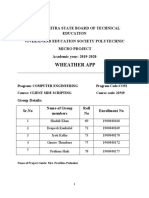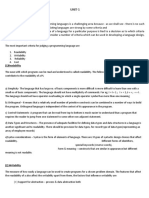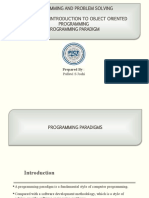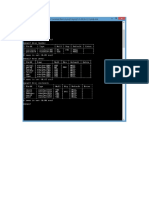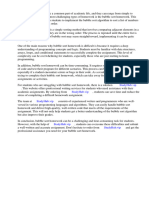Different Paradigms For Problem Solving
Uploaded by
Sandhya RaniDifferent Paradigms For Problem Solving
Uploaded by
Sandhya RaniProgramming Paradigms
Paradigm is a model that has distinct features, frameworks, patterns, and style which help
you solve a particular problem.
The languages may follow a particular paradigm or can be a combination of many
paradigms.
4 different programming paradigms –
Procedural,
Object-Oriented,
Functional and
Logical.
1. Procedural Programming
Procedural programming can also be referred to as imperative programming. It is a
programming paradigm based upon the concept of procedure calls, in which
statements are structured into procedures (also known as subroutines or functions).
They are a list of instructions to tell the computer what to do step by step, Procedural
programming languages are known as top-down languages. Most of the early
programming languages are all procedural.
Examples of Fortran C and Cobol. Here is a sample code in COBOL.
Features of Procedural Code
Procedural Programming is excellent for general-purpose programming
The coded simplicity along with ease of implementation of compilers and interpreters
A large variety of books and online course material available on tested algorithms,
making it easier to learn.
The source code is portable
The code can be reused in different parts of the program, without the need to copy it
The program flow can be tracked easily as it has a top-down approach.
2. Logical Programming
Logical programming is a computer programming paradigm that has its foundations
in mathematical logic in which program statements express facts and rules about
problems within a system. Rules are written as logical clauses with a head and a
body. They also follow a declarative rather than an imperative approach. However,
what does that mean?
To understand how a problem can be solved in logical programming, you need to
know about the building blocks − Facts and Rules −
Let us understand the difference between Imperative and declarative programming.
Imagine you walk into your favorite coffee place and you would like to order some
coffee.
The imperative approach will be:
Enter the coffee shop
Queue in the line and wait for the barista asking you for your order
Order
Yes, for takeaway, please
Pay
Present your loyalty card to collect points
Take your order and walk away
The declarative approach:
A large latte for takeaway, please
So rather than providing a step by step instruction (imperative), you tell the system
what you need and let it try to come up with a solution (declarative).
Prolog follows the Logical paradigm and is probably the most famous language in
the logical programming family.
Prolog has been enormously influential in the domains of theorem proving, expert
systems, natural language processing and in the field of artificial intelligence
(notably IBM’s Watson2) in general
Prolog, like SQL, has two main aspects, one to express the data and another to
query it. The basic constructs of logical programming, terms, and statements, are
inherited from logic. There are three basic statements:
Facts are fundamental assertions about the problem domain (e.g. "Socrates is a
man")
Rules are inferences about facts in the domain (e.g. "All men are mortal.")
Queries are questions about that domain (e.g. "Is Socrates mortal?")
Features of Logical Programming
Logical programming can be used to express knowledge in a way that does not
depend on the
implementation, making programs more flexible, compressed and understandable.
It enables knowledge to be separated from use, i.e. the machine architecture can be
changed
without changing programs or their underlying code.
It can be altered and extended in natural ways to support special forms of
knowledge, such
as meta-level of higher-order knowledge.
It can be used in non-computational disciplines relying on reasoning and precise
means of
expression.
3. Functional Programming
Functional programming is a programming paradigm where you have a style of
building the structure and elements of computer programs. Here you treat
computation as an evaluation of mathematical functions and you avoid changing-
state and mutable data.
Functional programming consists only of PURE functions. So, what do you
understand by Pure functions?
Pure functions are those which take an argument list as an input and whose output is
a return value. Now you may feel that all functions are pure as any function takes in
values and returns a value.
For example, if a function relies on the global variable or class member’s data, then it
is not pure. And in such cases, the return value of that function is not entirely
dependent on the list of arguments received as input and can also have side effects.
So, what do you understand by the term side effect? A side effect is a change in the
state of an application that is observable outside the called function other than its
return value. For example: Modifying any external variable or object property such as
a global variable, or a variable in the parent function scope chain.
Features of Functional Paradigm
Pure functions – As seen above, if the input is an array, the output will be a new
array and the input array will not be modified. So in case of pure functions, the output
depends only on the input.
Here’s a function in the language Scala that takes values and returns their sum.
scala> def add(a:Int,b:Int) = a + b
add: (a: Int, b: Int)Int
The add function caused no side-effects. It did not alter the input values provided, it
used another pure function, the + operator, and returned the sum of the values as
the result of the call. The add function is a pure function.
Recursion-A recursive function is a function that calls itself during its execution. This
enables the function to repeat itself several times, the result being outputted at the
end of each iteration. Below is an example of a recursive function.
Function Count (integer N)
if (N <= 0) return "Must be a Positive Integer";
if (N > 9) return "Counting Completed";
else return Count (N+1);
end function
The function Count() above uses recursion to count from any number between 1 and
9, to the number 10. For example, Count(1) would return 2,3,4,5,6,7,8,9,10. Count(7)
would return 8,9,10.
4. Object-Oriented Programming(OO):
In this framework, all real-world entities are represented by Classes. Objects are
instances of classes so each object encapsulates a state and behavior. State implies
the fields, attributes of the object and behavior is what you do with the state of the
object and they are the methods. Objects interact with each other by passing
messages.
Features of OO:
Encapsulation – This is a fundamental feature of Object-Oriented Programming.
Here you hide unnecessary details in classes and deliver a simple and clear interface
for working. It describes the idea of bundling data and methods that work on that data
within one unit. This concept is also often used to hide the internal representation, or
state, of an object from the outside
Inheritance - Inheritance is one of the core concepts of object-oriented programming
(OOP) languages. It is a mechanism where you can derive a class from another
class for a hierarchy of classes that share a set of attributes and methods. It explains
how the class hierarchies develop code readability and support to the reuse of
functionality.
Data Abstraction - to Data abstraction is the reduction of a particular body of data to
a simplified representation of the whole. Data abstraction is usually the first step in
database design.
Polymorphism - Polymorphism is an object-oriented programming concept that
refers to the ability of a variable, function or object to take on multiple forms.
Programming languages that have implemented the OO paradigm are: Ruby, Java,
C++, Python, Simula(the first OOP language)
You might also like
- Documentation of Course Registration System83% (6)Documentation of Course Registration System19 pages
- Modeling Conventions For Process GovernanceNo ratings yetModeling Conventions For Process Governance251 pages
- Object Oriented Programming With The TypescriptNo ratings yetObject Oriented Programming With The Typescript33 pages
- Programming Paradigms: A Must Know For All ProgrammersNo ratings yetProgramming Paradigms: A Must Know For All Programmers4 pages
- 3. Object Oriented Programming MODIFIED bongaNo ratings yet3. Object Oriented Programming MODIFIED bonga121 pages
- Discuss in Details 10 Each of Programming Paradigm and Computing TechnologyNo ratings yetDiscuss in Details 10 Each of Programming Paradigm and Computing Technology7 pages
- Algorithms and Data Structures: An Easy Guide to Programming SkillsFrom EverandAlgorithms and Data Structures: An Easy Guide to Programming SkillsNo ratings yet
- Programming Language Types and Paradigm: CS1303 - Object Oriented Programming Unit - I Java FundamentalsNo ratings yetProgramming Language Types and Paradigm: CS1303 - Object Oriented Programming Unit - I Java Fundamentals52 pages
- Paradigm Can Also Be Termed As Method To Solve Some Problem or Do Some Task. Programming ParadigmNo ratings yetParadigm Can Also Be Termed As Method To Solve Some Problem or Do Some Task. Programming Paradigm7 pages
- Lexicon of Programming Terminology: Lexicon of Tech and Business, #17From EverandLexicon of Programming Terminology: Lexicon of Tech and Business, #175/5 (1)
- Programming Paradigms - Rekik & HaileyesusNo ratings yetProgramming Paradigms - Rekik & Haileyesus7 pages
- Algorithms Made Simple: Understanding the Building Blocks of SoftwareFrom EverandAlgorithms Made Simple: Understanding the Building Blocks of SoftwareNo ratings yet
- Compare and Contrast Functional and Imperative Programming Languages (10 Marks)No ratings yetCompare and Contrast Functional and Imperative Programming Languages (10 Marks)7 pages
- Js4ap 7.0 Intro To Functional ProgrammingNo ratings yetJs4ap 7.0 Intro To Functional Programming18 pages
- Part 1 - Paradigms, Levels, and Importance of ProgrammingNo ratings yetPart 1 - Paradigms, Levels, and Importance of Programming23 pages
- Week 1 Lecture - Evolution of Programming LanguageNo ratings yetWeek 1 Lecture - Evolution of Programming Language15 pages
- CSC 4405 Survey of Programming Languages Lecture 2No ratings yetCSC 4405 Survey of Programming Languages Lecture 26 pages
- Subject Name: Principles of Programming LanguagesNo ratings yetSubject Name: Principles of Programming Languages6 pages
- UNIT-1 Language Evaluation Criteria:: (1) ReadabilityNo ratings yetUNIT-1 Language Evaluation Criteria:: (1) Readability11 pages
- Programming and Problem Solving Lecture - 3-Introduction To Object Oriented Programming Programming ParadigmNo ratings yetProgramming and Problem Solving Lecture - 3-Introduction To Object Oriented Programming Programming Paradigm14 pages
- Simulation of A Novel Scalable Group Key Management Protocol For Mobile Adhoc NetworksNo ratings yetSimulation of A Novel Scalable Group Key Management Protocol For Mobile Adhoc Networks7 pages
- Id Based Multicast Secret-Key Management Scheme (SKMS) in ManetsNo ratings yetId Based Multicast Secret-Key Management Scheme (SKMS) in Manets10 pages
- Week 11 SREE Refactoring + Design PatternsNo ratings yetWeek 11 SREE Refactoring + Design Patterns39 pages
- ExcelDna - FluentRibbon - Fluent Ribbon Builder For Add-InsNo ratings yetExcelDna - FluentRibbon - Fluent Ribbon Builder For Add-Ins6 pages
- Use NetBeans IDE 6.7 To Combine JAR Files Into A Single JAR FileNo ratings yetUse NetBeans IDE 6.7 To Combine JAR Files Into A Single JAR File1 page
- Oracle Forms Look & Feel Project: Developer GuideNo ratings yetOracle Forms Look & Feel Project: Developer Guide45 pages
- Optional Logic, If Any Subject Is Below 35 Marks Should Be Failed and Grade Should Be F and 35 and Above Should Be PassedNo ratings yetOptional Logic, If Any Subject Is Below 35 Marks Should Be Failed and Grade Should Be F and 35 and Above Should Be Passed2 pages
- Programming Paradigms: A Must Know For All ProgrammersProgramming Paradigms: A Must Know For All Programmers
- Discuss in Details 10 Each of Programming Paradigm and Computing TechnologyDiscuss in Details 10 Each of Programming Paradigm and Computing Technology
- Algorithms and Data Structures: An Easy Guide to Programming SkillsFrom EverandAlgorithms and Data Structures: An Easy Guide to Programming Skills
- Programming Language Types and Paradigm: CS1303 - Object Oriented Programming Unit - I Java FundamentalsProgramming Language Types and Paradigm: CS1303 - Object Oriented Programming Unit - I Java Fundamentals
- Mastering Data Structures and Algorithms in Python & JavaFrom EverandMastering Data Structures and Algorithms in Python & Java
- Paradigm Can Also Be Termed As Method To Solve Some Problem or Do Some Task. Programming ParadigmParadigm Can Also Be Termed As Method To Solve Some Problem or Do Some Task. Programming Paradigm
- Lexicon of Programming Terminology: Lexicon of Tech and Business, #17From EverandLexicon of Programming Terminology: Lexicon of Tech and Business, #17
- Mastering Computer Programming: A Comprehensive GuideFrom EverandMastering Computer Programming: A Comprehensive Guide
- Algorithms Made Simple: Understanding the Building Blocks of SoftwareFrom EverandAlgorithms Made Simple: Understanding the Building Blocks of Software
- Compare and Contrast Functional and Imperative Programming Languages (10 Marks)Compare and Contrast Functional and Imperative Programming Languages (10 Marks)
- Part 1 - Paradigms, Levels, and Importance of ProgrammingPart 1 - Paradigms, Levels, and Importance of Programming
- Week 1 Lecture - Evolution of Programming LanguageWeek 1 Lecture - Evolution of Programming Language
- CSC 4405 Survey of Programming Languages Lecture 2CSC 4405 Survey of Programming Languages Lecture 2
- UNIT-1 Language Evaluation Criteria:: (1) ReadabilityUNIT-1 Language Evaluation Criteria:: (1) Readability
- Programming and Problem Solving Lecture - 3-Introduction To Object Oriented Programming Programming ParadigmProgramming and Problem Solving Lecture - 3-Introduction To Object Oriented Programming Programming Paradigm
- Simulation of A Novel Scalable Group Key Management Protocol For Mobile Adhoc NetworksSimulation of A Novel Scalable Group Key Management Protocol For Mobile Adhoc Networks
- Id Based Multicast Secret-Key Management Scheme (SKMS) in ManetsId Based Multicast Secret-Key Management Scheme (SKMS) in Manets
- ExcelDna - FluentRibbon - Fluent Ribbon Builder For Add-InsExcelDna - FluentRibbon - Fluent Ribbon Builder For Add-Ins
- Use NetBeans IDE 6.7 To Combine JAR Files Into A Single JAR FileUse NetBeans IDE 6.7 To Combine JAR Files Into A Single JAR File
- Optional Logic, If Any Subject Is Below 35 Marks Should Be Failed and Grade Should Be F and 35 and Above Should Be PassedOptional Logic, If Any Subject Is Below 35 Marks Should Be Failed and Grade Should Be F and 35 and Above Should Be Passed

